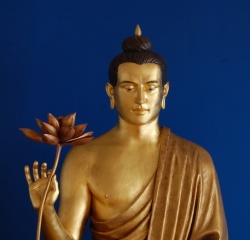Difference between revisions of "Kashgar"
m (Text replacement - "Central Asia" to "{{Wiki|Central Asia}}") |
|||
| Line 2: | Line 2: | ||
<poem> | <poem> | ||
[[Kashgar]] | [[Kashgar]] | ||
| − | [疏勒国] ( Jpn [[Soroku-koku]]) | + | [[疏勒国]] ( Jpn [[Soroku-koku]]) |
| − | An oasis city in | + | An oasis city in {{Wiki|Central Asia}} on the {{Wiki|western}} end of the {{Wiki|Tarim Basin}}, in what is now the {{Wiki|Sinkiang Uighur Autonomous Region}} of northwestern {{Wiki|China}}. Most of the inhabitants are {{Wiki|Uighurs}}, [[people]] of Turkic origin. [[Kashgar]] was an important location along the [[{{Wiki|Silk Road}}]] as a center of trade and traffic between the [[East]] and the [[West]]. Over the last two millennia, it has been the [[subject]] of frequent conquests by different peoples. {{Wiki|China}} occupied it, lost control, and regained control several times. According to The [[Record of the Western Regions]] by [[Hsüan-tsang]], who visited [[Kashgar]] in the seventh century, agri-culture and textile manufacturing prospered there. There were hundreds of [[Buddhist]] [[monasteries]] and more than ten thousand [[monks]] studying the [[doctrines]] of the [[Sarvastivada]] school. Though [[Hinayana]] [[Buddhism]] flourished there, it is noteworthy that fragments of the [[Sanskrit]] text of the [[Lotus Sutra]], a [[Mahayana sutra]], were recently uncovered in [[Kashgar]].In the tenth century, [[Kashgar]] fell under the {{Wiki|domination}} of the Turkish-Islamic Qarakhanid dynasty and became one of its two capitals. As a result, {{Wiki|Turkish}} and {{Wiki|Islamic}} {{Wiki|culture}} and [[religion]] took [[root]] there. [[Kashgar]] fell under the rule of the {{Wiki|Karakitai}} {{Wiki|dynasty}} in the twelfth century and of the {{Wiki|Mongols}} in the thirteenth and later centuries. In the mid-eighteenth century, [[Kashgar]] was occupied by the {{Wiki|Chinese}} {{Wiki|Ch'ing dynasty}}. |
</poem> | </poem> | ||
{{R}} | {{R}} | ||
[http://www.sgilibrary.org/search_dict.php?id=1169 www.sgilibrary.org] | [http://www.sgilibrary.org/search_dict.php?id=1169 www.sgilibrary.org] | ||
[[Category:]] | [[Category:]] | ||
Revision as of 21:32, 16 April 2014
Kashgar
疏勒国 ( Jpn Soroku-koku)
An oasis city in Central Asia on the western end of the Tarim Basin, in what is now the Sinkiang Uighur Autonomous Region of northwestern China. Most of the inhabitants are Uighurs, people of Turkic origin. Kashgar was an important location along the [[Silk Road]] as a center of trade and traffic between the East and the West. Over the last two millennia, it has been the subject of frequent conquests by different peoples. China occupied it, lost control, and regained control several times. According to The Record of the Western Regions by Hsüan-tsang, who visited Kashgar in the seventh century, agri-culture and textile manufacturing prospered there. There were hundreds of Buddhist monasteries and more than ten thousand monks studying the doctrines of the Sarvastivada school. Though Hinayana Buddhism flourished there, it is noteworthy that fragments of the Sanskrit text of the Lotus Sutra, a Mahayana sutra, were recently uncovered in Kashgar.In the tenth century, Kashgar fell under the domination of the Turkish-Islamic Qarakhanid dynasty and became one of its two capitals. As a result, Turkish and Islamic culture and religion took root there. Kashgar fell under the rule of the Karakitai dynasty in the twelfth century and of the Mongols in the thirteenth and later centuries. In the mid-eighteenth century, Kashgar was occupied by the Chinese Ch'ing dynasty.
Source
www.sgilibrary.org [[Category:]]
